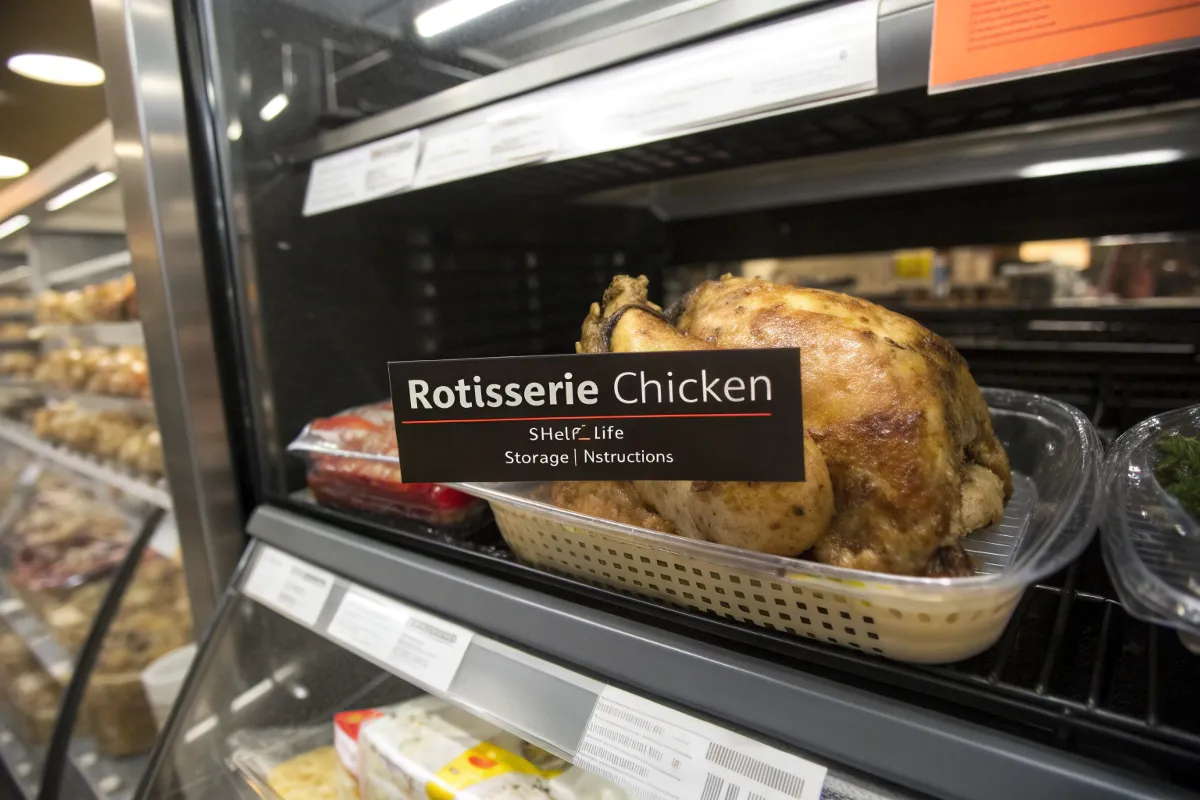Freezing cooked chicken is a convenient way to extend its shelf life, but questions about safety and quality often arise. Can I freeze rotisserie chicken after 4 days? This comprehensive guide tackles safety considerations, proper freezing methods, and tips to maintain flavor and texture. From understanding the risks of bacterial growth to discovering creative ways to use frozen rotisserie chicken, this article provides all the insights you need.
Understanding the Shelf Life of Rotisserie Chicken
The shelf life of rotisserie chicken, whether purchased from the store or cooked at home, plays a vital role in determining whether freezing after four days is safe. Knowing how long cooked chicken can stay fresh in the refrigerator and when it should be frozen helps ensure you avoid foodborne illnesses.
Why the Shelf Life Matters
Cooked chicken is a perishable food, and its freshness depends on proper storage. When kept refrigerated at a temperature below 40°F (4°C), cooked chicken typically lasts 3–4 days. However, beyond this timeframe, bacterial growth can increase, even if the food looks and smells fine.
Understanding this short window is crucial for making decisions about freezing. Freezing halts bacterial activity, preserving chicken that might otherwise go bad if left in the fridge longer.
Factors That Affect Shelf Life
Several factors influence how long rotisserie chicken remains safe to eat:
- Initial freshness: The fresher the chicken when cooked, the longer it will last before spoilage.
- Storage conditions: Maintaining a steady refrigerator temperature and keeping the chicken in airtight packaging slows spoilage.
- Handling practices: Using clean utensils and keeping the chicken covered reduces the risk of contamination.
Properly understanding these factors ensures you’ll know when to transfer chicken to the freezer.
When to Freeze Rotisserie Chicken
For the best results, it’s ideal to freeze rotisserie chicken within 1–3 days of cooking. That said, freezing it after four days can still be safe under certain circumstances, though it comes with caveats regarding quality and taste.
Safety Considerations
Is It Safe to Freeze Rotisserie Chicken After 4 Days?
The short answer is yes—but with certain conditions. Freezing halts bacterial growth, preserving the chicken from further spoilage. However, the safety largely depends on how the chicken was handled and stored before freezing. If the chicken has been kept in a clean, airtight container and consistently refrigerated at or below 40°F (4°C), freezing after four days can still be a safe option.
On the other hand, if the chicken shows signs of spoilage or has been left at room temperature for over two hours, freezing won’t reverse the damage. Foodborne bacteria, once present, can survive freezing and may become a health hazard when the chicken is thawed and reheated.
Understanding the nuances of bacterial growth and adhering to official guidelines ensures both safety and quality when freezing rotisserie chicken.
Bacterial Growth and Foodborne Illness Risks
Cooked chicken is a fertile ground for bacterial growth when stored improperly. Harmful microorganisms like Salmonella and Listeria can multiply rapidly when chicken is left at room temperature for extended periods. While refrigeration slows bacterial activity, it doesn’t stop it entirely.
After four days, the risk of bacterial presence increases, even if the chicken has been refrigerated. Freezing effectively stops bacterial growth but doesn’t kill bacteria already present. Therefore, freezing rotisserie chicken after four days is only safe if no contamination occurred during storage.
The real danger lies in reheating. Improper thawing or reheating can reactivate dormant bacteria, posing risks of foodborne illnesses. To mitigate this, always thaw frozen chicken using safe methods like refrigeration or cold water baths.
USDA Guidelines on Refrigerated and Frozen Poultry
The United States Department of Agriculture (USDA) provides clear guidelines to help consumers handle cooked poultry safely. According to their recommendations:
- Cooked poultry, including rotisserie chicken, should be refrigerated within two hours of cooking to minimize bacterial growth.
- It’s safe to store cooked chicken in the refrigerator for 3–4 days. Beyond this timeframe, the USDA advises freezing to maintain safety and quality.
- Frozen cooked chicken can last up to 4 months when properly packaged to avoid freezer burn.
Proper Storage Techniques
Best Practices for Storing Rotisserie Chicken Before Freezing
Storing rotisserie chicken correctly before freezing is crucial to ensure safety and preserve quality. Start by refrigerating the chicken as soon as possible after purchase or cooking. Place the chicken in an airtight container or wrap it tightly in plastic wrap to reduce exposure to air and moisture.
Avoid storing the chicken in its original packaging for extended periods, as it isn’t designed for long-term preservation. By transferring it to a freezer-safe container or bag, you can keep the chicken fresher for longer.
Labeling the container with the date ensures you’ll use the chicken within a safe timeframe, whether refrigerated or frozen.
Refrigeration Timeframes and Temperature Control
Maintaining a consistent refrigerator temperature below 40°F (4°C) is essential for extending the shelf life of rotisserie chicken. Even slight fluctuations can accelerate spoilage, especially if the refrigerator is frequently opened.
For maximum freshness, consume the chicken within three days. If you plan to freeze it, aim to do so as soon as possible—preferably within the first two days of refrigeration.
Storage tip: Keep the chicken in the coldest part of the refrigerator, typically at the back, where temperatures are more stable. Avoid placing the chicken in the refrigerator door, where temperatures fluctuate more.
Signs of Spoilage to Watch For
Before freezing, it’s critical to check the chicken for signs of spoilage. While the absence of visible or olfactory cues doesn’t guarantee safety, common spoilage indicators include:
- Unpleasant odors: A sour or off smell is a telltale sign of bacterial activity.
- Texture changes: Slimy or sticky surfaces suggest microbial growth.
- Discoloration: Gray or greenish hues indicate spoilage.
If any of these signs are present, freezing isn’t recommended, as the chicken may already harbor harmful bacteria. When in doubt, it’s better to err on the side of caution and discard questionable chicken.
Freezing Methods
How to Freeze Rotisserie Chicken Effectively
Freezing rotisserie chicken is a straightforward process, but doing it effectively requires attention to detail. Proper preparation and packaging are critical to maintain the chicken’s texture, flavor, and safety. Without the right techniques, the chicken might develop freezer burn, lose moisture, or become prone to contamination.
By following these steps, you can freeze your rotisserie chicken like a pro and ensure it tastes just as good when thawed and reheated.
Preparing the Chicken for Freezing
Preparation begins with portioning. If you’re not planning to use the entire chicken at once, divide it into smaller portions—this makes thawing easier and minimizes waste.
Remove any bones, especially if you plan to use the chicken for recipes that call for shredded or diced meat. While freezing whole chicken is an option, boneless pieces freeze more evenly and take up less space.
Ensure the chicken is fully cooled before freezing. Placing warm chicken in the freezer can cause temperature fluctuations that may affect other foods stored nearby.
Packaging Materials and Techniques
The packaging is where many people go wrong. Using the right materials and methods can mean the difference between a delicious, reheated chicken and a dried-out disappointment.
- Freezer-safe bags: Use heavy-duty freezer bags to prevent air exposure.
- Plastic wrap and foil: Double-wrap the chicken in plastic wrap and then in aluminum foil for extra protection.
- Vacuum-sealing: This is the best option for long-term storage, as it removes all air, preventing freezer burn.
Squeeze out as much air as possible from the packaging before sealing. The less air inside, the better the chicken will retain its original quality.
Labeling and Dating Frozen Chicken
Don’t skip this simple step! Clearly label each package with the date you froze it and a brief description (e.g., “Rotisserie chicken, dark meat”).
Frozen chicken is best consumed within four months, so having a clear record helps you prioritize what to use first. By managing your frozen foods effectively, you’ll avoid unintentional waste and ensure everything stays fresh.
Thawing and Reheating
Safe Thawing Methods for Frozen Rotisserie Chicken
Thawing frozen chicken safely is just as important as freezing it correctly. Using improper methods, such as leaving the chicken at room temperature, can lead to rapid bacterial growth. Fortunately, several safe thawing methods preserve both safety and quality.
Refrigerator Thawing
The refrigerator method is the safest option. Simply transfer the frozen chicken from the freezer to the refrigerator and let it thaw slowly.
This method may take several hours or even overnight, depending on the size of the portions, but the steady cold temperature prevents bacteria from multiplying.
Tip: Place the chicken on a plate or in a bowl to catch any juices that may leak during thawing, preventing cross-contamination with other foods.
Cold Water Thawing
If time is of the essence, cold water thawing is a quicker alternative. Submerge the chicken in a leak-proof plastic bag and place it in a bowl or sink filled with cold water.
Change the water every 30 minutes to maintain a safe temperature. This method usually takes a few hours, depending on the size of the chicken pieces.
While faster than refrigeration, it requires more monitoring. Avoid using hot water, as it can create warm spots where bacteria can grow.
Microwave Thawing Considerations
For a last-minute option, the microwave can be used to thaw rotisserie chicken. Most modern microwaves have a defrost setting that uses lower power to thaw food evenly.
However, this method comes with caveats. The edges of the chicken may start to cook before the center thaws completely, leading to uneven results. Plan to cook or reheat the chicken immediately after microwave thawing to avoid bacterial growth.
Reheating Rotisserie Chicken Safely
Once thawed, reheating the chicken properly ensures both safety and flavor. Improper reheating can dry out the meat or fail to kill bacteria that might have survived the freezing process.
Oven Reheating
The oven method is ideal for reheating large portions of rotisserie chicken. Preheat your oven to 350°F (175°C), place the chicken in a baking dish, and cover it with aluminum foil to retain moisture.
Reheat for 20–30 minutes, depending on the portion size, until the internal temperature reaches 165°F (74°C). Adding a splash of broth or water to the dish can help maintain juiciness.
Microwave Reheating
For smaller portions, the microwave is a convenient option. Place the chicken on a microwave-safe plate, cover it with a damp paper towel, and heat it in short intervals to prevent overcooking.
Check frequently to ensure the chicken is evenly reheated. While quick, this method can sometimes compromise the texture of the chicken, especially if it’s reheated too long.
Maintaining Quality During Reheating
Regardless of the reheating method, preserving the chicken’s quality is key. Use low and slow heat whenever possible to avoid drying out the meat.
For added flavor, consider incorporating the chicken into a recipe rather than serving it as-is. Options like soups, casseroles, and stir-fries can revitalize frozen and reheated chicken, making it taste freshly prepared.
Quality and Taste
Impact of Freezing on Rotisserie Chicken’s Texture and Flavor
Freezing is a great way to preserve rotisserie chicken, but it does affect its texture and flavor to some degree. When chicken is frozen, water inside the meat forms ice crystals. These crystals can damage the muscle fibers, leading to a slightly altered texture once thawed. The chicken may feel a bit drier or less tender.
Flavor changes are usually minimal, but improper storage—like exposure to air—can result in freezer burn, which impacts both taste and moisture. Thankfully, with proper preparation and storage techniques, you can minimize these effects and maintain the deliciousness of your rotisserie chicken.
Preventing Freezer Burn
Freezer burn occurs when frozen food is exposed to air, causing dehydration and oxidation. While it’s not harmful to consume freezer-burned chicken, the dry, tough spots can be unappetizing.
To avoid this:
- Double-wrap: Use a combination of plastic wrap and aluminum foil to create an airtight seal.
- Vacuum seal: Invest in a vacuum sealer to remove all air before freezing.
- Limit freezer time: Use frozen chicken within four months for the best quality.
Retaining Moisture and Juiciness
Chicken’s moisture and juiciness can sometimes diminish during freezing and thawing. However, there are simple ways to lock in that moisture:
- Flash freezing: If possible, freeze chicken quickly to form smaller ice crystals, which cause less damage to the meat.
- Add broth or butter: Before reheating, baste the chicken with broth or a small amount of butter to restore its succulence.
- Cover during reheating: Whether using an oven or microwave, keep the chicken covered to prevent moisture loss.
Utilizing Frozen Rotisserie Chicken
Creative Recipes Using Thawed Rotisserie Chicken
Thawed rotisserie chicken is a versatile ingredient that works beautifully in countless recipes. Instead of serving it plain, repurpose it into exciting dishes that bring new life to the meat.
From hearty soups to refreshing salads, there’s no shortage of ways to enjoy thawed rotisserie chicken. Let’s explore some creative ideas to inspire your next meal.
Soups and Stews
Thawed chicken is perfect for adding depth and protein to soups and stews. Whether it’s a comforting chicken noodle soup or a spicy tortilla soup, the rotisserie chicken’s seasoned flavor enhances the dish.
Shred the chicken and toss it into a simmering pot of broth along with vegetables, spices, and grains like rice or noodles. It’s an easy, hearty meal that warms the soul.
Salads and Sandwiches
For lighter fare, use thawed rotisserie chicken in salads and sandwiches. The chicken’s tender texture pairs wonderfully with fresh greens, crunchy vegetables, and tangy dressings.
- Chicken Caesar Salad: Toss shredded chicken with romaine lettuce, Parmesan cheese, croutons, and Caesar dressing.
- Club Sandwich: Layer sliced chicken with lettuce, tomatoes, and mayonnaise between toasted bread for a satisfying lunch.
These quick, refreshing meals are perfect for when you’re short on time but craving something delicious.
Casseroles and Bakes
Transform your thawed rotisserie chicken into a cozy, comforting casserole or bake. Combine the chicken with creamy sauces, cheese, and pasta or rice for a dish that’s hearty and satisfying.
Popular options include chicken pot pie, chicken Alfredo bake, or cheesy chicken and rice casserole. These recipes are ideal for feeding a crowd or meal-prepping for the week ahead.
Frequently Asked Questions (FAQs)
FAQs About Freezing Rotisserie Chicken
Many people have questions about freezing rotisserie chicken, especially when it comes to safety, quality, and best practices. Below, we answer some of the most common inquiries to help you make informed decisions about freezing, storing, and using this versatile food.
How Long Can You Keep Rotisserie Chicken in the Freezer?
Rotisserie chicken can be safely stored in the freezer for up to four months, provided it’s properly packaged in airtight, freezer-safe containers or wrapped tightly in plastic and foil. While the chicken remains safe to eat beyond this period, the quality may begin to decline, with potential loss of flavor and texture.
Label your packages with the freezing date to ensure you use the chicken within its optimal time frame for taste and freshness.
Can You Freeze Rotisserie Chicken on the Bone?
Yes, you can freeze rotisserie chicken on the bone, but removing the meat before freezing has advantages. Boneless chicken takes up less space, freezes more evenly, and is quicker to thaw and use.
However, if you’re short on time, freezing the chicken whole or on the bone is perfectly fine. Just ensure it’s tightly wrapped and stored properly to prevent freezer burn.
Does Freezing Affect the Nutritional Value of the Chicken?
Freezing rotisserie chicken does not significantly alter its nutritional value. Protein, vitamins, and minerals remain intact during freezing. However, slight nutrient losses might occur in water-soluble vitamins, like vitamin B, due to moisture loss during freezing and thawing.
Overall, freezing is a reliable method for preserving the nutritional benefits of cooked chicken while extending its usability.
Is It Safe to Refreeze Thawed Rotisserie Chicken?
It’s generally not recommended to refreeze chicken that has been thawed unless it was thawed in the refrigerator and hasn’t been left at room temperature. Refreezing thawed chicken can lead to texture deterioration and increase the risk of bacterial contamination.
If you anticipate needing smaller portions, divide the chicken into smaller packages before freezing to avoid repeated thawing and refreezing.
What Are the Signs That Frozen Rotisserie Chicken Has Gone Bad?
Even frozen chicken can go bad if stored improperly or for too long. Here are some telltale signs:
- Discoloration: Gray or dark spots on the chicken indicate spoilage.
- Unpleasant odor: A sour or rancid smell is a clear warning.
- Texture changes: If the chicken feels slimy after thawing, it’s likely spoiled.
Can You Freeze Store-Bought Rotisserie Chicken Without Repackaging?
While you can freeze store-bought rotisserie chicken in its original packaging, it’s not the best practice for long-term storage. The packaging may not be airtight or freezer-safe, which can lead to freezer burn or quality degradation.
For better results, transfer the chicken to a freezer-safe container or wrap it in plastic and foil before freezing. Proper packaging ensures maximum freshness and flavor when thawed.



